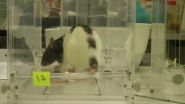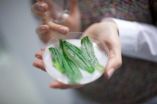(Press-News.org) Researchers from Northwestern University and the University of New Mexico report evidence for potentially oceans worth of water deep beneath the United States. Though not in the familiar liquid form -- the ingredients for water are bound up in rock deep in the Earth's mantle -- the discovery may represent the planet's largest water reservoir.
The presence of liquid water on the surface is what makes our "blue planet" habitable, and scientists have long been trying to figure out just how much water may be cycling between Earth's surface and interior reservoirs through plate tectonics.
Northwestern geophysicist Steve Jacobsen and University of New Mexico seismologist Brandon Schmandt have found deep pockets of magma located about 400 miles beneath North America, a likely signature of the presence of water at these depths. The discovery suggests water from the Earth's surface can be driven to such great depths by plate tectonics, eventually causing partial melting of the rocks found deep in the mantle.
The findings, to be published June 13 in the journal Science, will aid scientists in understanding how the Earth formed, what its current composition and inner workings are and how much water is trapped in mantle rock.
"Geological processes on the Earth's surface, such as earthquakes or erupting volcanoes, are an expression of what is going on inside the Earth, out of our sight," said Jacobsen, a co-author of the paper. "I think we are finally seeing evidence for a whole-Earth water cycle, which may help explain the vast amount of liquid water on the surface of our habitable planet. Scientists have been looking for this missing deep water for decades."
Scientists have long speculated that water is trapped in a rocky layer of the Earth's mantle located between the lower mantle and upper mantle, at depths between 250 miles and 410 miles. Jacobsen and Schmandt are the first to provide direct evidence that there may be water in this area of the mantle, known as the "transition zone," on a regional scale. The region extends across most of the interior of the United States.
Schmandt, an assistant professor of geophysics at the University of New Mexico, uses seismic waves from earthquakes to investigate the structure of the deep crust and mantle. Jacobsen, an associate professor of Earth and planetary sciences at Northwestern's Weinberg College of Arts and Sciences, uses observations in the laboratory to make predictions about geophysical processes occurring far beyond our direct observation.
The study combined Jacobsen's lab experiments in which he studies mantle rock under the simulated high pressures of 400 miles below the Earth's surface with Schmandt's observations using vast amounts of seismic data from the USArray, a dense network of more than 2,000 seismometers across the United States.
Jacobsen's and Schmandt's findings converged to produce evidence that melting may occur about 400 miles deep in the Earth. H2O stored in mantle rocks, such as those containing the mineral ringwoodite, likely is the key to the process, the researchers said.
"Melting of rock at this depth is remarkable because most melting in the mantle occurs much shallower, in the upper 50 miles," said Schmandt, a co-author of the paper. "If there is a substantial amount of H2O in the transition zone, then some melting should take place in areas where there is flow into the lower mantle, and that is consistent with what we found."
If just one percent of the weight of mantle rock located in the transition zone is H2O, that would be equivalent to nearly three times the amount of water in our oceans, the researchers said.
This water is not in a form familiar to us -- it is not liquid, ice or vapor. This fourth form is water trapped inside the molecular structure of the minerals in the mantle rock. The weight of 250 miles of solid rock creates such high pressure, along with temperatures above 2,000 degrees Fahrenheit, that a water molecule splits to form a hydroxyl radical (OH), which can be bound into a mineral's crystal structure.
Schmandt and Jacobsen's findings build on a discovery reported in March in the journal Nature in which scientists discovered a piece of the mineral ringwoodite inside a diamond brought up from a depth of 400 miles by a volcano in Brazil. That tiny piece of ringwoodite -- the only sample in existence from within the Earth -- contained a surprising amount of water bound in solid form in the mineral.
"Whether or not this unique sample is representative of the Earth's interior composition is not known, however," Jacobsen said. "Now we have found evidence for extensive melting beneath North America at the same depths corresponding to the dehydration of ringwoodite, which is exactly what has been happening in my experiments."
For years, Jacobsen has been synthesizing ringwoodite, colored sapphire-like blue, in his Northwestern lab by reacting the green mineral olivine with water at high-pressure conditions. (The Earth's upper mantle is rich in olivine.) He found that more than one percent of the weight of the ringwoodite's crystal structure can consist of water -- roughly the same amount of water as was found in the sample reported in the Nature paper.
"The ringwoodite is like a sponge, soaking up water," Jacobsen said. "There is something very special about the crystal structure of ringwoodite that allows it to attract hydrogen and trap water. This mineral can contain a lot of water under conditions of the deep mantle."
For the study reported in Science, Jacobsen subjected his synthesized ringwoodite to conditions around 400 miles below the Earth's surface and found it forms small amounts of partial melt when pushed to these conditions. He detected the melt in experiments conducted at the Advanced Photon Source of Argonne National Laboratory and at the National Synchrotron Light Source of Brookhaven National Laboratory.
Jacobsen uses small gem diamonds as hard anvils to compress minerals to deep-Earth conditions. "Because the diamond windows are transparent, we can look into the high-pressure device and watch reactions occurring at conditions of the deep mantle," he said. "We used intense beams of X-rays, electrons and infrared light to study the chemical reactions taking place in the diamond cell."
Jacobsen's findings produced the same evidence of partial melt, or magma, that Schmandt detected beneath North America using seismic waves. Because the deep mantle is beyond the direct observation of scientists, they use seismic waves -- sound waves at different speeds -- to image the interior of the Earth.
"Seismic data from the USArray are giving us a clearer picture than ever before of the Earth's internal structure beneath North America," Schmandt said. "The melting we see appears to be driven by subduction -- the downwelling of mantle material from the surface."
The melting the researchers have detected is called dehydration melting. Rocks in the transition zone can hold a lot of H2O, but rocks in the top of the lower mantle can hold almost none. The water contained within ringwoodite in the transition zone is forced out when it goes deeper (into the lower mantle) and forms a higher-pressure mineral called silicate perovskite, which cannot absorb the water. This causes the rock at the boundary between the transition zone and lower mantle to partially melt.
"When a rock with a lot of H2O moves from the transition zone to the lower mantle it needs to get rid of the H2O somehow, so it melts a little bit," Schmandt said. "This is called dehydration melting."
"Once the water is released, much of it may become trapped there in the transition zone," Jacobsen added.
Just a little bit of melt, about one percent, is detectible with the new array of seismometers aimed at this region of the mantle because the melt slows the speed of seismic waves, Schmandt said.
INFORMATION:
The USArray is part of EarthScope, a program of the National Science Foundation that deploys thousands of seismic, GPS and other geophysical instruments to study the structure and evolution of the North American continent and the processes the cause earthquakes and volcanic eruptions.
The National Science Foundation (grants EAR-0748797 and EAR-1215720) and the David and Lucile Packard Foundation supported the research.
The paper is titled "Dehydration melting at the top of the lower mantle." In addition to Jacobsen and Schmandt, other authors of the paper are Thorsten W. Becker, University of California, Los Angeles; Zhenxian Liu, Carnegie Institution of Washington; and Kenneth G. Dueker, the University of Wyoming.
New evidence for oceans of water deep in the Earth
Water bound in mantle rock alters our view of the Earth's composition
2014-06-12
ELSE PRESS RELEASES FROM THIS DATE:
With the right rehabilitation, paralyzed rats learn to grip again
2014-06-12
VIDEO:
This video depicts Restored grasping after immunotherapy and rehabilitative training.
Click here for more information.
Only if the timing, dosage and kind of rehabilitation are right can motor functions make an almost full recovery after a large stroke. Rats that were paralyzed down one side by a stroke almost managed to regain their motor functions fully if they were given the ideal combination of rehabilitative training and substances that boosted the growth of nerve fibers. ...
Unexpected origin for important parts of the nervous system
2014-06-12
A new study from Karolinska Institutet in Sweden shows that a part of the nervous system, the parasympathetic nervous system, is formed in a way that is different from what researchers previously believed. In this study, which is published in the journal Science, a new phenomenon is investigated within the field of developmental biology, and the findings may lead to new medical treatments for congenital disorders of the nervous system.
Almost all of the body's functions are controlled by the autonomous, involuntary nervous system, for example the heart and blood vessels, ...
Scientists discover link between climate change and ocean currents over 6 million years
2014-06-12
Scientists have discovered a relationship between climate change and ocean currents over the past six million years after analysing an area of the Atlantic near the Strait of Gibraltar, according to research published today (Friday, 13 June) in the journal Science.
An expedition of scientists, jointly led by Dr Javier Hernandez-Molina, from the Department of Earth Sciences at Royal Holloway, University of London, examined core samples from the seabed off the coast of Spain and Portugal which provided proof of shifts of climate change over millions of years.
The team ...
Habitat fragmentation increases vulnerability to disease in wild plants
2014-06-12
Proximity to other meadows increases disease resistance in wild meadow plants, according to a study led by Anna-Liisa Laine at the University of Helsinki. The results of the study, analysing the epidemiological dynamics of a fungal pathogen in the archipelago of Finland, will be published in Science on 13 June 2014.
The study surveyed more than 4,000 Plantago lanceolata meadows and their infection status by a powdery mildew fungus in the Åland archipelago of Finland. The surveys have continued since 2001, resulting in one of the world's largest databases on disease dynamics ...
Quantum computation: Fragile yet error-free
2014-06-12
This news release is available in German and Spanish. Even computers are error-prone. The slightest disturbances may alter saved information and falsify the results of calculations. To overcome these problems, computers use specific routines to continuously detect and correct errors. This also holds true for a future quantum computer, which will require procedures for error correction as well: "Quantum phenomena are extremely fragile and error-prone. Errors can spread rapidly and severely disturb the computer," says Thomas Monz, member of Rainer Blatt's research group ...
Movies with gory and disgusting scenes more likely to capture and engage audience
2014-06-12
Washington, DC (June 12, 2014) – We know it too well. We are watching a horror film and the antagonist is about to maim a character; we ball up, get ready for the shot and instead of turning away, we lean forward in the chair, then flinch and cover our eyes – Jason strikes again! But what is going on in our body that drives us to this reaction, and why do we engage in it so readily? Recent research published in the Journal of Communication found that people exposed to core disgusts (blood, guts, body products) showed higher levels of attention the more disgusting the content ...
NASA takes Tropical Cyclone Nanuak's temperature
2014-06-12
Tropical Cyclone Nanauk is holding its own for now as it moves through the Arabian Sea. NASA's Aqua satellite took its cloud top temperatures to determine its health.
In terms of infrared data viewing tropical cyclones, those with the coldest cloud top temperatures indicate that a storm is the most healthy, most robust and powerful. That's because thunderstorms that have strong uplift are pushed to the top of the troposphere where temperatures are bitter cold. Infrared data, such as that collected from the Atmospheric Infrared Sounder (AIRS) instrument that flies aboard ...
Findings point toward one of first therapies for Lou Gehrig's disease
2014-06-12
CORVALLIS, Ore. – Researchers have determined that a copper compound known for decades may form the basis for a therapy for amyotrophic lateral sclerosis (ALS), or Lou Gehrig's disease.
In a new study just published in the Journal of Neuroscience, scientists from Australia, the United States (Oregon), and the United Kingdom showed in laboratory animal tests that oral intake of this compound significantly extended the lifespan and improved the locomotor function of transgenic mice that are genetically engineered to develop this debilitating and terminal disease.
In humans, ...
Scientists identify Deepwater Horizon Oil on shore even years later, after most has degraded
2014-06-12
Years after the 2010 Deepwater Horizon Oil spill, oil continues to wash ashore as oil-soaked "sand patties," persists in salt marshes abutting the Gulf of Mexico, and questions remain about how much oil has been deposited on the seafloor. Scientists from Woods Hole Oceanographic Institution and Bigelow Laboratory for Ocean Sciences have developed a unique way to fingerprint oil, even after most of it has degraded, and to assess how it changes over time. Researchers refined methods typically used to identify the source of oil spills and adapted them for application on a ...
Anti-dsDNA, surface-expressed TLR4 and endosomal TLR9 cooperate to exacerbate lupus
2014-06-12
Systemic lupus erythematosus (SLE) is a complicated multifactorial autoimmune disease influenced by many genetic and environmental factors. The hallmark of systemic lupus erythematosus (SLE) is the presence of high levels of anti-double-stranded DNA autoantibody (anti-dsDNA) in sera. In addition, greater infection rates are found in SLE patients and higher morbidity and mortality usually come from bacterial infections. Deciphering interactions between the susceptibility genes and the environmental factors for lupus complex traits is challenging and has resulted in only ...
LAST 30 PRESS RELEASES:
Why nail-biting, procrastination and other self-sabotaging behaviors are rooted in survival instincts
Regional variations in mechanical properties of porcine leptomeninges
Artificial empathy in therapy and healthcare: advancements in interpersonal interaction technologies
Why some brains switch gears more efficiently than others
UVA’s Jundong Li wins ICDM’S 2025 Tao Li Award for data mining, machine learning
UVA’s low-power, high-performance computer power player Mircea Stan earns National Academy of Inventors fellowship
Not playing by the rules: USU researcher explores filamentous algae dynamics in rivers
Do our body clocks influence our risk of dementia?
Anthropologists offer new evidence of bipedalism in long-debated fossil discovery
Safer receipt paper from wood
Dosage-sensitive genes suggest no whole-genome duplications in ancestral angiosperm
First ancient human herpesvirus genomes document their deep history with humans
Why Some Bacteria Survive Antibiotics and How to Stop Them - New study reveals that bacteria can survive antibiotic treatment through two fundamentally different “shutdown modes”
UCLA study links scar healing to dangerous placenta condition
CHANGE-seq-BE finds off-target changes in the genome from base editors
The Journal of Nuclear Medicine Ahead-of-Print Tip Sheet: January 2, 2026
Delayed or absent first dose of measles, mumps, and rubella vaccination
Trends in US preterm birth rates by household income and race and ethnicity
Study identifies potential biomarker linked to progression and brain inflammation in multiple sclerosis
Many mothers in Norway do not show up for postnatal check-ups
Researchers want to find out why quick clay is so unstable
Superradiant spins show teamwork at the quantum scale
Cleveland Clinic Research links tumor bacteria to immunotherapy resistance in head and neck cancer
First Editorial of 2026: Resisting AI slop
Joint ground- and space-based observations reveal Saturn-mass rogue planet
Inheritable genetic variant offers protection against blood cancer risk and progression
Pigs settled Pacific islands alongside early human voyagers
A Coral reef’s daily pulse reshapes microbes in surrounding waters
EAST Tokamak experiments exceed plasma density limit, offering new approach to fusion ignition
Groundbreaking discovery reveals Africa’s oldest cremation pyre and complex ritual practices
[Press-News.org] New evidence for oceans of water deep in the EarthWater bound in mantle rock alters our view of the Earth's composition






